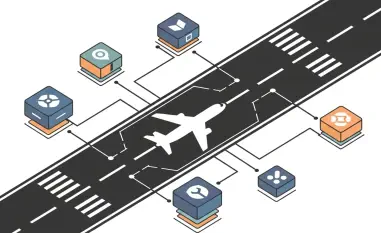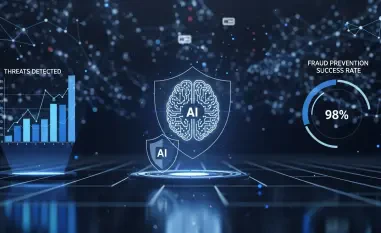The integration of artificial intelligence (AI) into cybersecurity has significantly transformed how organizations approach their digital threat landscapes. With its dual nature as both a protective ally and a tool for cybercriminals, AI is reshaping the boundaries of security, requiring immediate and strategic adaptation. This transformation necessitates a deep understanding of AI’s potential to bolster defenses while simultaneously recognizing its capacity to empower sophisticated cyber threats. As AI continues to evolve at an unprecedented pace, the challenge lies in harnessing its capabilities to enhance security measures effectively.
Understanding AI’s Dual Role in Cybersecurity
AI as a Defense Mechanism
Artificial intelligence has emerged as a formidable tool in the cybersecurity arsenal, providing unparalleled advancements in threat detection and response precision. Organizations are leveraging machine learning algorithms to sift through vast amounts of data, identifying patterns indicative of potential security breaches with remarkable accuracy. For instance, AI-driven technologies enable enterprises to process millions of transactions to detect fraudulent behavior swiftly, enhancing security without disrupting legitimate operations. The ability to automate responses to threats reduces the reaction time significantly, enabling a more efficient defense. Moreover, AI systems offer the advantage of continually learning from new data, evolving to identify and counteract emerging threats more effectively.
The implementation of AI also extends to customer-facing applications, minimizing false positives that can hinder user experience and operational flow. As technology evolves, the emphasis has shifted from solely preventing breaches to improving detection rates and response effectiveness. However, while these advancements provide robust security enhancements, they require significant investment and expertise to maintain. Organizations must ensure that their AI systems are continuously updated and optimally configured to counter evolving cyber threats, making ongoing education and resource allocation critical.
AI as a Tool for Cybercriminals
Conversely, AI is increasingly exploited by cybercriminals to launch more sophisticated and targeted attacks. The same machine learning capabilities that strengthen defense mechanisms can simultaneously be utilized to identify and exploit vulnerabilities. Attackers deploy AI to create personalized phishing schemes, leveraging generative algorithms to mimic genuine correspondence closely. As a result, these attacks are more likely to deceive recipients, leading to an increase in successful breaches. Additionally, the rise of deepfake technology has introduced a new level of complexity, where cybercriminals can impersonate individuals with alarming accuracy.
These enhancements allow attackers to bypass traditional security measures with relative ease, presenting a significant challenge for organizations. The development of synthetic identities and the manipulation of data through AI tools further complicate the identification and mitigation of fraudulent activities. It is crucial for cybersecurity teams to stay ahead of such evolving threats by employing advanced AI-driven countermeasures, fostering a proactive stance rather than a reactive one. Failure to do so may result in significant financial and reputational damages.
Challenges in Sector-Specific AI Threats
Financial Sector Vulnerabilities
In the financial sector, AI’s role is critical and presents both opportunities and risks. Institutions utilize AI to forecast market trends and automate client services, enhancing transactional efficiency and security. However, the same advancements also expose the sector to new vulnerabilities. Cybercriminals seek to exploit AI-enhanced systems to create fraudulent transactions or manipulate financial data, often circumventing traditional security layers. This necessitates a robust and adaptive AI strategy, emphasizing real-time threat analysis and automated threat response systems to mitigate potential breaches.
Addressing these threats requires financial institutions to balance the integration of innovative AI solutions with rigorous testing and oversight. A comprehensive understanding of both the technological capabilities and the associated risks is essential to maintaining secure operations. Furthermore, collaborations with technology partners and regulatory bodies play a crucial role in developing and reinforcing protective frameworks. As the sector continues to digitize, ensuring that AI applications are both innovative and secure is paramount to sustaining trust and operational integrity.
Healthcare Sector Threats
Healthcare systems, with their sensitive data repositories and often outdated infrastructures, are prime targets for AI-driven cyberattacks. The aging legacy systems frequently found in healthcare facilities lack the robust defenses necessary to counter contemporary AI-enhanced threats. Cybercriminals see opportunities in exploiting vulnerabilities through ransomware and data breaches, potentially compromising patient information and disrupting essential services. This scenario underscores the urgency of modernizing healthcare IT frameworks, integrating resilient security measures that can preempt and neutralize threats effectively.
To combat these issues, healthcare providers must prioritize the integration of AI solutions that can adaptively secure patient data and ensure the integrity of medical systems against unauthorized access. This demands a concerted effort in investing in new technologies, training personnel in AI literacy, and developing strategic partnerships to enhance security infrastructures. Regulatory compliance and the adoption of standardized AI frameworks can also offer a structured approach to addressing these challenges, fostering a secure environment for technological advancement in healthcare.
Regulatory Landscape and Private Enterprise Response
Emerging Global Regulations
The global perspective on AI risk management is evolving, with regulations increasingly focusing on mitigating dual-use threats posed by AI technologies. Governments and international bodies are pushing for regulatory frameworks that appropriately address the benefits and dangers associated with AI in cybersecurity. The EU AI Act illustrates a comprehensive effort to ascertain safe deployment practices, promoting transparency and accountability among organizations. At the same time, U.S. initiatives, such as the Executive Order on AI, highlight a commitment to upholding security and trustworthiness in AI applications.
The creation and enforcement of these regulations aim to establish a cohesive understanding of AI’s potential impact across sectors, promoting ethical practices and minimizing misuse. It is evident that as AI becomes more integrated into daily operations, so must the legal and ethical standards that govern its use. Organizations are encouraged to align their practices with these emerging guidelines, ensuring compliance while leveraging AI’s full potential responsibly.
Enterprise Lag and Adaptation
Despite regulatory advancements, many enterprises lag in implementing robust AI security strategies, resulting in heightened vulnerability. Research indicates that only a minor fraction of organizations possess comprehensive policies governing AI use or offer adequate training initiatives. This oversight underscores a critical gap in awareness and governance, leaving enterprises exposed to escalating AI-driven threats. The reliance on outdated defense mechanisms exacerbates this situation, emphasizing the need for strategic modernization and comprehensive policy implementation.
To close this gap, organizations must recognize the imperative of establishing AI-specific security frameworks that incorporate risk assessments and employee education. By fostering a culture of cybersecurity awareness, enterprises can better prepare themselves against the dynamic threat landscape that AI presents. It is essential for businesses to prioritize resource allocation towards innovative security solutions, thereby ensuring robust defenses that dynamically respond to new challenges.
A New Approach to Legacy Systems and Defense
Modernizing Legacy Systems
Legacy systems remain a significant challenge for many organizations, hampering their ability to effectively counter AI-driven threats. These outdated infrastructures are ill-equipped to handle real-time threat detection capabilities necessary for modern cybersecurity strategies. As AI attacks grow more sophisticated, it becomes increasingly vital for businesses to upgrade their technology stacks. Modernization efforts should focus on integrating AI-compatible systems, allowing for enhanced predictive analytics and automated threat response functionalities.
Replacing legacy systems with cutting-edge technology not only strengthens an organization’s defense but also enhances overall operational efficiency. The transition requires careful planning and investment, prioritizing scalable solutions that align with current technological advancements. It’s crucial for organizations to collaborate with technology experts to ensure a seamless implementation process, minimizing disruptions while maximizing security enhancements. Additionally, investing in continuous learning and development for IT teams ensures ongoing proficiency in managing advanced cybersecurity tools.
Embedding a Cybersecurity Culture
Cultivating a cybersecurity-centric business culture is paramount in the face of AI’s evolving impact on security landscapes. By embedding cybersecurity as a strategic priority at all organizational levels, companies can foster a proactive approach to threat management. This shift transforms cybersecurity from a mere IT concern to a core element of business operations, prompting senior leadership to take an active role in security strategy. Encouraging open discussions about AI risks and security innovations can further promote a vigilant organizational mindset.
Implementing comprehensive training programs and awareness campaigns is essential to instill a culture of security among employees. By ensuring that staff understand the significance of cybersecurity practices and the role they play in safeguarding organizational assets, businesses can create a unified defense strategy. Moreover, establishing clear communication channels for reporting and addressing security issues encourages a supportive environment where employees feel empowered to act as vigilant gatekeepers.
Preparing for AI-Driven Cyber Threats
Strategic Moves for Organizations
As AI evolves, organizations must undertake strategic initiatives to remain resilient against sophisticated cyber threats. Establishing dedicated AI cybersecurity policies is crucial in guiding the safe deployment and monitoring of AI technologies. Expanding employee training programs to include AI threat literacy is also vital, ensuring the workforce comprehends potential risks and appropriate defensive measures. Such initiatives foster a well-informed environment, allowing for proactive threat detection and mitigation.
Technology modernization remains critical, with organizations encouraged to invest in adaptive cybersecurity tools compatible with emerging AI technologies. Continuous innovation ensures defenses are robust, quick to adapt, and scalable according to threat landscapes. Moreover, encouraging a cybersecurity-centric culture ensures commitment throughout all business levels, transforming security into a shared responsibility rather than a siloed function. Emphasizing collaboration aligns efforts across departments, optimizing resource utilization for maximum impact.
Leadership and Risk Assessment
Leadership must emphasize the importance of comprehensive AI cybersecurity risk assessments, ensuring the identification of potential vulnerabilities within current operations. These assessments allow organizations to gauge their preparedness effectively, offering insights into possible improvements. Educating senior leadership on AI threats ensures informed decision-making, promoting strategic investments in security advancements. Additionally, simulating AI-driven attacks tests organizational resilience, highlighting areas of strength and weakness.
Establishing dedicated AI governance committees further solidifies the commitment to secure operations. These committees oversee the development and enforcement of clear policies, promoting alignment with regulatory standards and best practices. By fostering leadership that prioritizes AI security, organizations can ensure continuous adaptation in response to technological developments. This commitment positions businesses to thrive in the face of AI’s double-edged impact, securing operational longevity and reinforcing trust with stakeholders.
Future Considerations for Cybersecurity Leaders
AI’s Continued Influence on Cybersecurity
As AI continues to shape the cybersecurity landscape, leaders must acknowledge its transformative power on both attack and defense dynamics. The persistent evolution of AI-driven threats necessitates an agile approach to security management, emphasizing rapid detection, isolation, and recovery from breaches. Cybersecurity’s future hinges on resilience, with the ability to adapt and respond effectively to threats determining organizational success.
Cybersecurity leaders are encouraged to reassess traditional security strategies, pivoting towards innovative solutions that encompass AI capabilities. Emphasizing collaborative efforts with industry experts and regulatory bodies ensures that best practices evolve in tandem with technological advancements. By fostering a culture of continual learning and adaptation, organizations remain at the forefront of cybersecurity, prepared to counter emerging threats effectively.
Building a Secure AI Future
The integration of artificial intelligence (AI) into cybersecurity has profoundly altered how organizations address their digital threat landscapes. AI’s dual role as both a protective ally and a potential tool for cybercriminals is reshaping the limits of security, necessitating immediate and strategic adaptation. This integration requires a thorough comprehension of AI’s ability to strengthen defenses while acknowledging its potential to empower increasingly sophisticated cyber threats. AI’s rapid evolution and growth present a unique challenge to security experts, who must leverage its advanced capabilities to improve security protocols effectively. Balancing AI’s benefits requires proactive adjustments to cybersecurity strategies to ensure that AI’s transformative power is harnessed properly to enhance defense measures. This ongoing adaptation will be crucial for organizations aiming to protect themselves in an ever-evolving digital environment, ensuring their systems remain resilient against modern threats despite the dynamic nature of AI.













